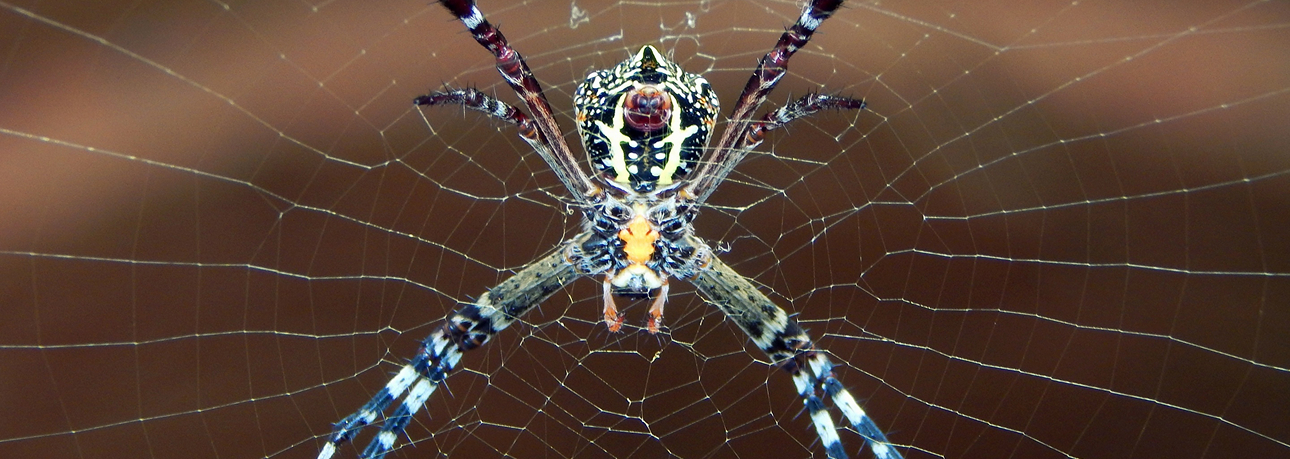Spider Control & Removal Services
Spiders in Orange County
Spiders are a common sight in Orange County, often found in homes, gardens, and outdoor spaces. While most spiders are harmless and even beneficial for controlling other pests, some species can be unwelcome guests due to their webbing, presence in living spaces, or potential venomous bites. Understanding the types of spiders in the area, their behavior, and the best control methods can help keep them in check.

Common Spiders in Orange County
Black Widow Spider
Identification
Black widows are glossy black with a distinctive red hourglass marking on the underside of their abdomen. Females are about 1.5 inches long, while males are significantly smaller and less noticeable.
Behavior
These spiders prefer dark, secluded areas such as garages, sheds, woodpiles, and under outdoor furniture. They construct irregular, sticky webs close to the ground to trap insects. While their venom is potent, black widow bites are rarely fatal but can cause significant pain and medical complications.
Common Spiders in Orange County
Black Widow Spider
Identification
Black widows are glossy black with a distinctive red hourglass marking on the underside of their abdomen. Females are about 1.5 inches long, while males are significantly smaller and less noticeable.
Behavior
These spiders prefer dark, secluded areas such as garages, sheds, woodpiles, and under outdoor furniture. They construct irregular, sticky webs close to the ground to trap insects. While their venom is potent, black widow bites are rarely fatal but can cause significant pain and medical complications.
Brown Widow Spider
Identification
Similar to the black widow but lighter in color, brown widows are tan to dark brown with an orange or yellowish hourglass marking on their abdomen. They are slightly smaller than black widows.
Behavior
Brown widows favor sheltered locations like outdoor furniture, fence posts, eaves, and plant pots. They tend to be less aggressive than black widows but still possess venom that can cause mild to moderate symptoms if bitten.
Cellar Spiders
Identification
Also known as "daddy longlegs," cellar spiders have small bodies with long, delicate legs. They range in color from pale yellow to light brown or gray.
Behavior
These harmless spiders are commonly found in basements, attics, garages, and corners of rooms. They create messy, tangled webs to capture small insects and are known to prey on more dangerous spiders, including black widows.
Tangle Web Spiders
Identification
Tangle web spiders are small to medium-sized, with a body shape similar to widow spiders but often with more subdued markings. They are usually brown or black and have a rounded abdomen.
Behavior
These spiders create irregular, messy webs in corners, under furniture, and in outdoor structures. Their webs are designed to trap unsuspecting insects. Unlike orb-weaving spiders, which build symmetrical webs, tangle web spiders rely on their sticky, chaotic webbing to capture prey.
Life Cycle
Spiders undergo a simple metamorphosis consisting of egg, juvenile, and adult stages. Female spiders lay eggs in silk sacs, which hatch into spiderlings that grow through multiple molts before reaching maturity. Most spiders live for about a year, though some species can survive longer.
diet
Spiders primarily feed on insects, including flies, mosquitoes, moths, and other pests. Their predatory nature makes them essential for natural pest control, reducing populations of nuisance insects in homes and gardens.
habitat
Spiders thrive in a variety of environments, from outdoor vegetation and woodpiles to indoor corners, basements, and garages. They seek sheltered areas where they can construct webs or burrows to capture prey.
Key Takeaways and Control Methods
Spiders play a crucial role in the ecosystem by controlling insect populations, but they can become a problem when they invade homes. Here are some effective ways to manage and prevent spider infestations:
Regular Cleaning
Remove webs, dust corners, and vacuum frequently to deter spiders from settling indoors.
Eliminate Entry Points
Seal cracks, gaps, and openings around windows, doors, and vents to keep spiders outside.
Reduce Clutter
Clear out storage areas, garages, and basements where spiders may hide or build webs.
Outdoor Maintenance
Trim vegetation away from the home, clear debris, and remove woodpiles to minimize spider habitats.
Lighting Adjustments
Reduce outdoor lighting or use yellow bulbs to avoid attracting insects that serve as spider prey.
Targeted Treatments
Professional pest control treatments can help manage severe infestations and keep spider populations under control.
Effective spider control requires keen attention to detail. Because spiders can travel in unique ways, such as ballooning through the air, a standard perimeter spray isn’t always enough to keep them at bay. That’s why our approach goes beyond basic treatments—we take the time to target each individual spider directly, ensuring they’re completely eliminated. Once the spiders are gone, we remove unsightly webs, restoring your space to a clean, spider-free state. Our thorough, hands-on approach doesn’t just reduce spider activity—it wipes them out like they were never even there.
our services
Simple Solutions To Complex Problems at an Affordable Rate

Residential
We offer a variety of plans custom fit for your needs! Whether its an endless trail of ants, or strange noises in the walls, we’ve got your pest control needs covered!

Commercial
We can stop pests from causing costly machinery repairs, fines, closures, and damage to your reputation!

rodents
Various species of rats and mice inhabit the Orange County area. Remove rodents from your home permanently with our exclusion services.

mosquito
We use the In2Care system to eliminate mosquitoes where they breed—protecting your family’s health and comfort.

